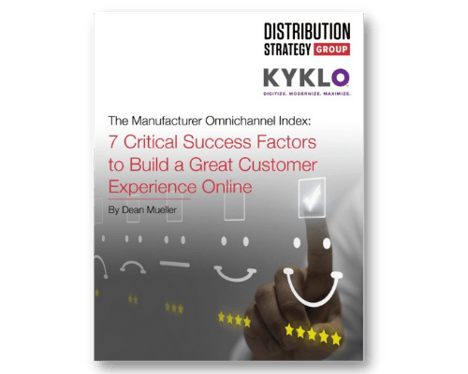

B2B E-commerce for Manufacturers: 5 Mistakes to Avoid
The e-commerce space has seen dramatic changes in the past few years, with B2B e-commerce platforms growing in popularity and becoming increasingly more complex. For manufacturers looking to deploy a B2B e-commerce solution, choosing the right platform is key to success.
But there are some common mistakes that manufacturers make when choosing industrial e-commerce solutions. If you are a manufacturer who is trying to penetrate the B2B e-commerce space, it is important to keep your goals clear, your expectations realistic, and to understand the correct approach to B2B e-commerce.
5 Mistakes to Avoid
1. Choosing a Partner that Only Offers Custom Solutions
Yes, an e-commerce platform should be to your liking and should match your brand, but, as an example, opting for a web agency that only offers custom solutions could be a costly move. Too much focus on the graphical user interface (GUI) can lead to neglecting core functionality. Plus, the web agency will likely not have the technical expertise required to manage industrial B2B electromechanical products.
There's no one-size-fits-all when it comes to selecting a web agency e-commerce partner, but if you want to have success in the B2B area, make sure to choose a partner a web agency that focuses solely on e-commerce solutions and has the technical expertise you need.
2. Prioritizing Popularity
Many B2B manufacturers opt for the most popular platform available as it promises visibility across search engines and customers alike. What many manufacturers don’t realize is that these platforms are great for B2C businesses, but they often lack B2B capabilities, such as multiple addresses, multiple prices per customer, warehouse location, invoicing, price records and inventory levels.
These B2B features are important for B2B manufacturers who want to provide a good customer experience and ensure that orders are fulfilled correctly and quickly. If the platform does not offer B2B capabilities, then you will end up spending more money on development or having to switch platforms altogether.
Therefore, it is essential to make sure that the B2B e-commerce platform you choose is built with B2B features in mind and can handle the wide range of SKUs and large quantities of data that B2B business entails.
3. Most Carts Are B2C, Not B2B
B2B e-commerce platforms have different requirements than B2C platforms, such as predetermined shipping methods and payment terms (credit terms, not just credit cards).
Another thing to consider isIt is also important to consider the features that the platform offers. B2B e-commerce requires features such as repeat orders, PO numbers and invoicing that are not typically found in B2C platforms.
Also, B2B e-commerce platforms accommodate multiple buyers per account, while B2C platforms typically accommodate just one buyer, and one delivery address, no payment terms, and few payment methods, which significantly limits the experience offered to your customers.
The predetermined shipping and payment terms for B2B customers are also very different from those for B2C, so it is important to make sure that the platform you choose has the ability to accommodate these differences. By considering these factors, you make sure you choose a platform that understands the nuances of B2B e-commerce.
Discover how you can stand out from the crowd.
The hesitation to digitize is holding back many manufacturers’ potential for providing a great customer experience (CX) online. Whether your top goal is a shopping or a transaction site, the essence of a good customer experience requires content to be on point or you risk losing your customers to competition.
In this report, we dive into the components that determine the Online Customer Experience by analyzing over 110 of the largest manufacturers in the electrical and automation sector. You'll discover how many manufacturers fall into the "good to great" category, but also examples of what an exceptional customer experience looks like.
4. Buying a Platform that Can’t Seamlessly Integrate with Your Current Systems
You already have multiple business systems. So, choosing a platform that can't easily integrate with those systems disrupts your daily operations—and your budget. It will take you multiple person-hours, several resources, and significant costs to get the two systems up and running together.
On average, the integration of two systems takes two years or more, depending on complexity. But if you choose the right platform, the integration can be seamless—and much faster. You can be online in a matter of weeks.
Integration is the most expensive aspect of buying a new system. Expect to pay upwards of $100,000. This investment is not only a huge chunk that you could instead use to reinvest in your business, but also a huge risk, given the possibility of poor project management that stems from not understanding details about information flow. This is a hindrance not only for those who manage the project, but also for other departments that rely on the system.
Then there’s the matter of speed. A typical ERP communicates at 1.6 million data points a day, while an average pricing database sees 100 million data points daily. So, you need to pick a system that handles large amounts of data without crashing or slowing down page requests. Otherwise, this will affect user experience and possibly lead to customers abandoning your site.
5. Overlooking How the Platform Helps Buyers Search
Choosing a platform that provides users with advanced search capabilities is key to making sure your customers easily and quickly find the products they are looking for. Filtering, sorting, and taxonomy are just some of the features you should look out for when selecting a B2B e-commerce platform.
%20(1).png?width=605&height=403&name=KYKLO%20thumbnail%20(6%20%C3%97%204%20in)%20(1).png) Filtering allows users to conduct more targeted searches, including by category, manufacturer, and price range. The problem is when taxonomies aren’t normalized. For example, air conditioners are often called cooling units, and manufacturers are fond of differentiating their products with novel names, which confuses buyers. Likewise, do relays belong under the relays category or under the line voltage category? How you categorize your products matters to searchers. Some B2C platforms give you little choice because they are not built for engineers and other technical buyers and the ways they search for products.
Filtering allows users to conduct more targeted searches, including by category, manufacturer, and price range. The problem is when taxonomies aren’t normalized. For example, air conditioners are often called cooling units, and manufacturers are fond of differentiating their products with novel names, which confuses buyers. Likewise, do relays belong under the relays category or under the line voltage category? How you categorize your products matters to searchers. Some B2C platforms give you little choice because they are not built for engineers and other technical buyers and the ways they search for products.
Remember, your website visitors have their own way of searching for products. A typical searcher might enter a supplier name and the category of product or technology they are looking for. They may also search by part number, or with a combination of the two. In order to make sure your customers can find what they need on your site, you need a platform that indexes and stores as many product images, documents and data sheets as possible. This way, all the necessary information is available and ease of use is maximized.
Try KYKLO’s eSOM today
Getting caught up in the surplus of e-commerce options can be overwhelming. Choosing an e-commerce platform tailored explicitly to B2B manufacturing makes a huge difference in your business’ efficiency, sales, and customer satisfaction.
For manufacturers looking for a comprehensive solution that integrates with their ERP, PIM, and CRM systems, KYKLO is the perfect solution.
The Bottom Line
Investing in an e-commerce platform is rewarding when you do it correctly. Being aware of B2B e-commerce for manufacturers mistakes to avoid helps you ensure that your business runs smoothly, maximizes your ROI, and increases customer satisfaction.
Choosing a B2B platform that is well-integrated with other systems saves time, reduces costs and gives your customers an improved user experience. Make sure to invest enough time, and consider multiple B2B e-commerce platforms, to feel confident you find the best solution for your unique requirements.
To learn more about our Product Information and E-commerce Platform for B2B Distributors and Manufacturers, book your demo now.



